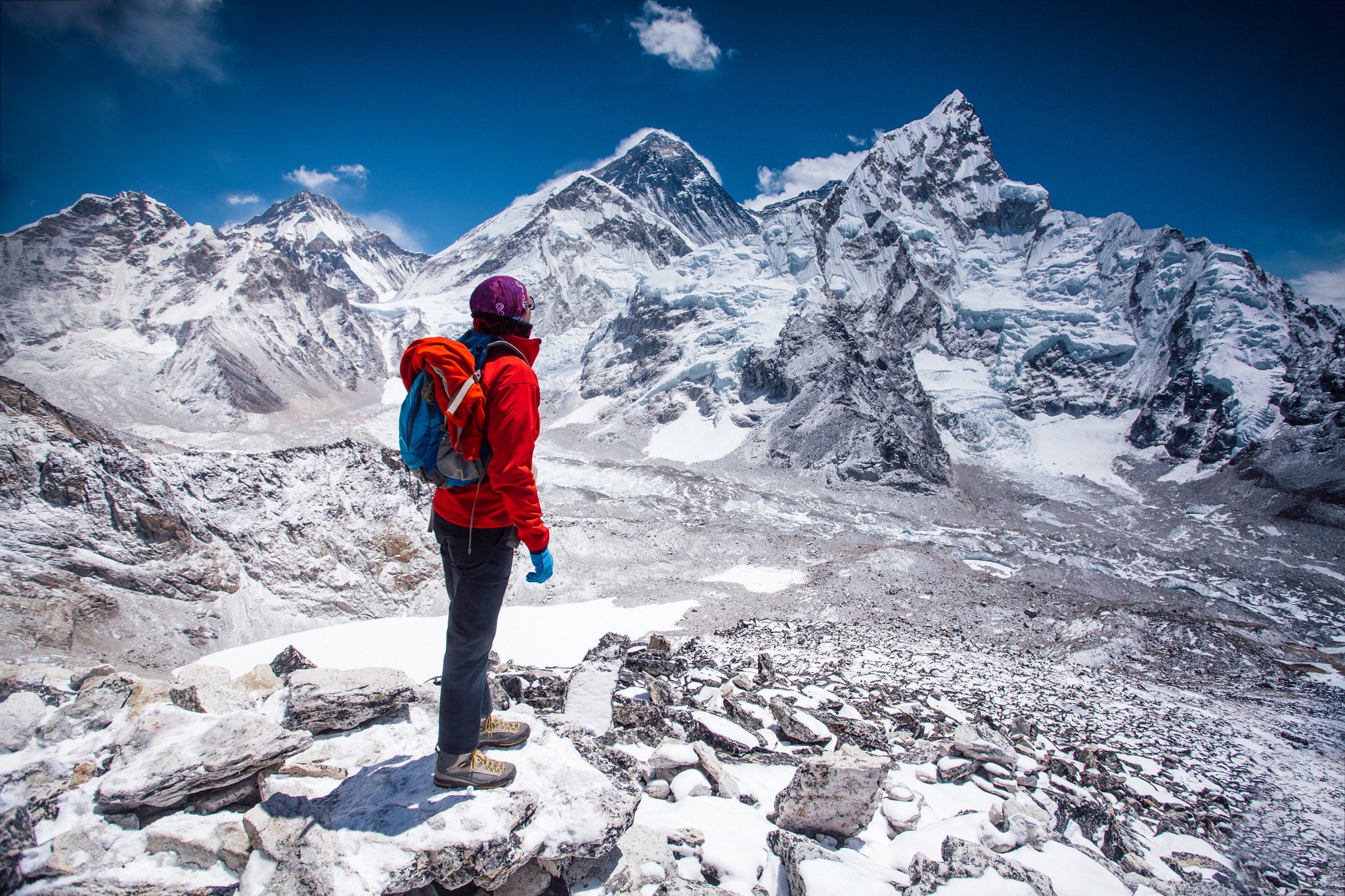Is Your Dream to Climb Mt. Everest? Here's What it Takes!

Do you have some incredible items on your bucket list? Are you determined to see yourself on the top of Mt. Everest, proud of all the dreams you've brought to fruition and all the hard work you've put in? While climbing Mt. Everest is an incredible goal--only around 800 people attempt it each year, and thus far, just over 4,800 have made it to the summit--you can accomplish your dreams and do more than you ever thought possible when you realize that you genuinely do have what it takes to make the climb. Join Meriwool Layers as we take to down the path of preparation to see what it it takes to climb Mt. Everest
The Challenge
Mt. Everest: the world's tallest mountain. Standing 29,029 feet tall, Everest crosses both Nepal and Tibet. As the world's tallest mountain, it poses an incredible challenge for climbers who are looking for the ultimate achievement. Each year, only around half of the 1200 people who apply for permits make it to the summit, with just 600 climbers reaching that height annually.
Subfreezing altitude, low oxygen, and sudden storms can all pose serious hazards for hikers, as can falls and avalanches. Because of the high altitude, supplemental oxygen is necessary to make the climb into the higher reaches of Mt. Everest. It's a climb made only by the elite, though increasing interest in taking the challenge has led to larger crowds, which has caused some overcrowding on the trails. More than 300 people have died making the attempt, many of whom still rest on Everest to this day.
Do you have what it takes to reach the summit of Mt. Everest? Are you ready to take on the challenge? Make sure you have what it takes to push forward.
Preparing for the Cost
Climbers who want to tackle Mt. Everest face one large immediate challenge: the cost. Mt. Everest is not a hike that can be tackled inexpensively. The average climber spends between $30,000-$45,000 just to attempt to climb Everest. Some companies charge $60,000 or more to provide guides and help each hiker make the attempt. The Everest climb is a risky proposition. Fees include helicopter rides, trail maintenance, environmental improvements, and life insurance for each participant, which is a necessity for everyone making the Everest climb.
Checking Your Health
Before you start planning to climb Mt. Everest, go in for a checkup. The last thing you want is to put all this time and money into preparing for the climb, only to discover when you're finally ready to undertake it that you aren't physically able. Now is the time to give up smoking and drinking and start eating healthy. Too much fat in your arteries can increase your odds of developing frostbite--not to mention the fact that you may have a harder time making the climb with excessive extra body weight. Climbing Mt. Everest means making a commitment, not just to the funds and the effort, but to your entire lifestyle. Talk with your doctor about what you'll need to do, medically speaking, to be healthy enough to make the climb.
The Timing
It generally takes around two months to successfully climb Mt. Everest. Climbers typically make the attempt to reach the summit in May, during the short window between winter and monsoon season. A successful climber, however, usually begins the expedition in mid-March, long before it starts to warm up significantly.
If you're planning to make the climb, of course, you'll want to be sure that you have plenty of time to do it successfully--the last thing you want is to find yourself held back by time limitations or finishing your climb in the middle of the worst possible weather. Working with an experienced guide is the most effective way to make the Everest climb at the best possible time of year.
The Right Attitude
Making the Everest climb isn't something that you can attempt on a whim. High altitude and freezing temperatures are not for the faint of heart--nor are they for someone who threw together a bucket list based on the most insane things they could come up with. To make the Everest climb, you must start with a deep desire to accomplish exactly this climb--and you need the right attributes as you move forward.
Tenacity is critical. The going will get tough. There will be times when you want to turn back--and times when you wonder why you ever thought this would be a good idea. It's all worth it when you reach the summit, but in the meantime, you have to dig in and get there! You also need to believe in yourself: to know that you can accomplish things you never dreamed possible, even when you're sure that your body is going to give out and that you're at the end of your resources. Without the right attitude, you'll never be able to reach the Everest summit--but with it, you can go the distance and accomplish your dreams.
The Right Clothing
In order to successfully climb Mt. Everest, you'll need all the right gear--and that includes clothing that will keep you warm and protected from the elements. Merino wool, for example, is highly breathable, but very warm. It wicks moisture away from the skin, preventing you from getting cold and clammy as you work up a sweat on your way up the mountain. Between BC and C3, you'll need to wear multiple layers of clothing, since the temperature may shift drastically depending on cloud cover or sun. You'll also need:
- A heavy down suit--ideally with an extra for nighttime
- Heavy down mittens, including an extra pair for your summit attempt
- Waterproof gloves
- A cap to protect your head
- Layers: lightweight synthetic fabrics, fleece, and wool are recommended by many Everest climbers because they are lightweight, durable, and easy to take on and off
- Extra lightweight merino wool socks to keep your feet warm and toasty
- A heat-exchanging, wired face mask
Professional-Quality Gear
Climbing Mt. Everest is not an undertaking for a casual hiker or climber. You want to make sure you have all the right gear for your journey, including:
- A harness
- Carabiners (go simple and large, rather than looking for the screw-type carabiners)
- Crampons, including extras
- Ice ax
- Rope
- Maps
- A good, reliable compass
- Cooking utensils (including a cook--remember, the Everest expedition is a long-term investment and a journey, not something that happens overnight)
- High-quality tents
- Sleeping bags
- Pads for under your sleeping bags
- Gas
- Water purification
- All of your documentation, including extra copies of vital documents
- Supplemental oxygen
- Medical supplies
Technical Expertise and Physical Experience
Even with the best attitude in the world and the perfect gear, climbing Everest is not a decision you make on the spur of the moment. Before you undertake your Everest journey, you need significant expertise and training. Many professional climbers recommend approaching Mt. Everest as a five-year process: before you make the climb, you'll need to make several shorter expeditions to help strengthen your body. Try some of these steps to help get in that key training:
If you're starting from zero, start with some long hikes with a loaded pack. Pack up as much gear as you can handle. You may find that you need to gradually increase the weight you're carrying in your pack over time until you're able to get up to Everest standards.
Get some mountaineering training. Check out your local mountaineering group or get connected to a larger group within your country. Those lower-elevation mountains are a great place to start building your experience--not to mention learning whether you really enjoy climbing and hiking enough to go on the Everest expedition. Kilimanjaro is an excellent starting point for a lower-elevation climb. Then, work up to Mount Blanc and Ebrus. There are many mountains around the world where you can slowly build experience and get in the best possible physical shape for your Everest climb. These climbs will also help you build your experience with all the gear you'll need on Everest without putting you in quite as much danger if your expertise or your equipment fails you.
Build your cardio endurance. Climbing Everest is grueling--and you need the cardio endurance to stand up to it. Add in significant amounts of running: up to 7-8 miles per day on hilly terrain to help build your cardiovascular fitness and prepare you for the challenges.
Don't skip the weights. As you prepare for your Everest climb, keep in mind that your backpack may easily weigh as much as 30 lbs. Adding weight lifting to your training regime can help prepare you for your climb and prevent you from lagging behind others on your expedition.
A Supportive Crew
No one wants to climb Everest alone. There's safety in numbers, whether you're in the early part of your journey or headed to the summit. Take the right people on your journey with you! While you'll make friends along the way, there's something comforting about taking the right people on your Everest climb from the beginning.
Whether you're heading off to scale Mt. Everest or your climbing endeavors are a little less lofty, make sure you're prepared with all the right clothing. Merino wool clothing will keep you cozy and warm at a relatively light weight--the perfect combination for your Mt. Everest expedition or your shorter climb. Contact us today to learn more about how we can get you outfitted for your climb.
Written by: Emily Goodman



